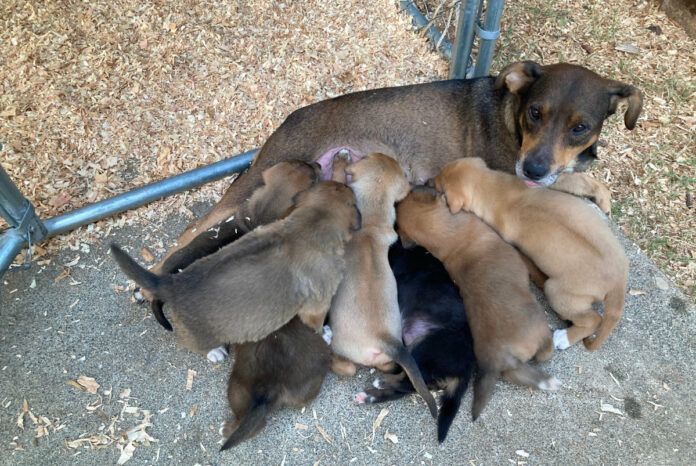I’m thinking today about how communities interact with their local animal control/animal shelters and vice versa, and how shelters can most meaningfully affect the wellbeing of animals in that community.
This has been on my mind as I am fostering a mother dog and seven of her puppies, who all technically belong to a homeless person in my community. The mother was wandering in search of food, and was being repeatedly posted on a local “lost and found pets” page. I offered to foster the family, with the proviso that the mother get spayed and the puppies get turned over to my local shelter (where they would be vaccinated, spayed/neutered, microchipped, and adopted to qualified families), and through a third party, the owner agreed. I’ve got the whole family at my house for a few weeks, until the mom dries up and can have surgery, and the pups are old enough to be adopted.
Of course, I couldn’t do this without the support of my local shelter, the Northwest SPCA in Oroville, CA, who not only agreed to take on the chore of providing all the medical care and adopting out the pups when it’s time, but will provide the spay surgery for the mama, too. It’s a win for the community, as this wasn’t this dog’s first litter in our town; soon, there will be eight fewer potentially reproducing mixed-breed dogs in our community.
Many municipal animal shelters operate under contract to their host city, county, or both, to provide animal control services, such as taking bite reports, catching and holding stray animals (in hopes of reuniting them with their owners), taking custody of pets when their owners die or are indisposed by illness or have been arrested, picking up dead animals, and more. Some shelters are required by their contracts to take in animals that are surrendered by their owners; some don’t take owner-surrendered animals at all; and others take on this responsibility on a volunteer basis, sometimes picking and choosing which animals they will take.
Most shelters also maintain some sort of adoption program for unclaimed stray animals and owner-surrendered animals.
Some shelters invest a lot in community outreach. This often takes the shape of an annual or semi-annual vaccination and/or microchipping clinic, and/or lower-cost or even free spay/neuter services. These services are aimed at increasing the number of licensed, vaccinated, neutered, and microchipped pets in the community, with the long-term goal of reducing strays and unwanted litters.
Then there are the organizations that go the extra mile. Many shelters maintain some sort of account that can be tapped occasionally to pay for some extraordinary veterinary care for an especially needy and especially worthy shelter ward, and they may occasionally ask for donations to that fund. Sometimes, having the money and will to save an animal with extraordinary medical needs and a particularly poignant story is not just an investment in the animal, as well as the community of animal lovers who help support the shelter, but also the staff! It hurts to have to make hard decisions and be faced with overwhelming need every single day, and being able to help a worthy candidate recover and find a forever home, even if the medical bills cost thousands and thousands, helps reduce the pain of not being able to help every single one.
One organization I’m aware of is a paragon of providing services to the animals in their community – but it’s at least partly because they are not a municipal shelter, burdened with animal control services. Downtown Dog Rescue is a nonprofit organization that specifically supports low-income pet owners in under-served communities in Los Angeles County. They do anything they can do to help pets stay with their families. They sometimes build fences for people whose dogs keep getting out and who can’t afford the recovery fees and “dog at large” fines. They frequently give vouchers to homeless and low-income people so they can obtain needed veterinary care for their beloved pets. They maintain a special fund that pays for private euthanasia services at a veterinary clinic when a family has an old or sick animal in need of this service, so the pet doesn’t have to take his or her last breath in the back room of a shelter with strangers.
There isn’t a shelter manager that wouldn’t agree with me about the usefulness of these tactics. The trouble – usually – is funding. Often, shelters are already strapped for funds – they need donations to help cover the work they already do. The shelters or organizations that have the most success are those that have been able to find a social media or marketing manager to relentlessly raise funds, telling the stories about what great things they have been able to do for the community’s animals.
Again, Downtown Dog Rescue is a great example. On a daily basis, they post something on Facebook about what they are doing. They tell stories about the dogs and people they have helped lately. They ask for donations frequently, but they also let people see how they spend the money they receive and provide updates on the dogs they’ve helped. They are one of the few non-local animal welfare groups that regularly inspire me to send them money!
Is there something that your local shelter or animal welfare group does that serves your community in a particularly useful way? Share the story! And if you are aware of how they accomplish their mission, tell us that, too! Maybe another shelter can learn something that they feel they could take on, too.







I want to complement Animal Control of El Dorado County, they have stepped up big time when 15 to 20,000 of us were evacuated due to the Caldor Fire. They took your animal with only are you stating your address that proved you were evacuated and they still continue to care for those who have not returned to their homes at no charge. Volunteers stepped up to help feed and excerise the large number of animals surrendered temporarily. I have patient children who allowed me and my two not so well trained dogs stay with them for 16 days. But Animal Control of El Dorado county deserves hugs and pats on the back for a job well done.
Stray Rescue of St. Louis just bought and outfitted a spay/neuter bus. Besides sending one brave little woman into the basements of abandoned houses, across busy on ramps, through literal garbage dumps, and into meth labs to scoop out neglected and abandoned animals, they now send a big red bus covered in rescued dog and cat photos to the most low-income and under-served areas of St. Louis, MO to vaccinate and alter dogs and cats for free. Residents are also invited to email or call and get pet food and litter assistance through the Pet Food Pantry their director started at the beginning of the pandemic, and the locations of those assistance requests help the team decide where the bus is likely most needed as well. Finally, they offer free puppy socialization classes and group walks, as well as some of the lowest-cost behavioral help in their area, with two CPDT-KA trainers on staff, and don’t balk at any case. Separation anxiety, fear related aggression, excessive prey drive, leash and barrier reactivity– they help any dog they possibly can. Great group, one I’m proud to assist.
I think the kind of information you are sharing here is the most important of all subjects concerning animals. The more info we can share as to how other shelters handle their over populated shelters is of great help. They all need that one person who is so motivated to publicly promote the shelters so they can get public help or donations. Good job Whole Dog Journal for spreading the word for the animals. We all need to step up.